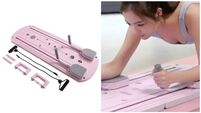TikTok's Sophie Laird: 'I am sat at home folding my clothes, and I don’t care'

Sophie Laird: "Marie Kondo is a professional organiser – I’m not. I’m a retailer who has a skill in folding - I was really good at merchandising." Pic: Max Rose-Fyne
From thongs to pancakes, frocks to phone cables, it turns out there’s nothing you can’t fold. What’s more, there’s nothing people won’t watch on TikTok, which is how you can amass 4.7 million followers by simply filming yourself folding.
Meet Sophie Laird, the Folding Lady of TikTok, who did exactly this. She has just published her first book, eponymously titled The Folding Lady, having become TikTok famous by folding socks online during lockdown. “It was a simple nine-second video,” she writes.
“I went from 20k followers to 120k in the space of a few days... the sock video is currently on 4.4 million views, and I will forever remember it as a big moment for me.”
To get a flavour of TikTok, she recounts how for her very first post, which she did in tandem with a friend, the friend posted herself cleaning a carpet with a handheld pet hair duster. It got one million views.
Sophie, who is from Manchester and now lives in Surrey with her husband and two children, currently has 4.1 million followers. She differentiates herself from spark-joy tidying lady Marie Kondo – whom she calls an “organiser” – because organisers tend not to show how to actually fold. Sophie does. She describes herself as a master folder.
“I’ve only seen Marie Kondo on Netflix,” she tells me. “I haven’t done her course or read her books, but I look up to her as someone who has brought folding to the forefront. She started it. I love her vibe. She’s very relaxing to watch. But she’s a professional organiser – I’m not. I’m a retailer who has a skill in folding - I was really good at merchandising.”
Sophie began what she calls her ‘folding journey’ while working in a department store aged 16. Seeing a pile of folded jeans “made me happy just looking at them; it soothed me and filled me with instant calm.”
She remained in retail for the next 15 years, until she was furloughed during lockdown.
“As a retailer, I have so much respect for clothes and what they can do for a person,” she says. “Sometimes I feel like we don’t give them enough love, especially how we store them.” She talks about “respecting our purchases”, and how she finds tidying and folding therapeutic.
She was, she says, a shopaholic, and a people-pleaser greatly influenced by magazines, social media, and other people. “I ate certain foods because they were in magazines and I thought it would impress people if I told them,” she explains.
“I would jump on every trend possible, to feel to part of it, to feel a connection to the way advertising made me feel I should be and could be, and that desired connection only ever came about 10% of the time.” Instead, she describes “a toxic cycle, whereby with all the stuff I was buying I was expecting to find happiness but always finding sadness.”

During her second pregnancy she had what she describes as “an awakening”, moving away from the compare-and-despair of too much Instagram and being overly dictated to by external trends, and focusing instead on what made her feel genuinely happy. “You want to be the coolest, and then you realise you’re doing things you don’t want to do,” she says.
“You’re not being your authentic self. And one day I just woke up and wondered what was I doing, that what I was doing was crazy. I realised that I was allowing myself to be influenced, that they [social media etc] were not talking to me as an individual.”
Instead, she discovered something she calls ‘after value’, which she defines as “a positive feeling, a confirmation, a reason, a value for doing something – whether it’s spending time with someone or buying a product.” She adds, “You’ll never feel guilty if you used after value as a currency because it’s authentic. It’s made by your asking, why am I buying this?”
In other words, a kind of mindful consumerism that doesn’t result in a house stuffed with impulse purchases.
She describes how she had spent the equivalent cost of a holiday on clothing she’d never worn, and the feelings that can arise from a purge: embarrassment (the amount of money spent on stuff you didn’t use); horror (at the amount of clothes still with their tags on); upset (at recognising what you could have spent the money on); shock (at the purchases you forgot about); and annoyance (that you’ve been complaining about not having enough space). When she shared online about decluttering her impulse purchases, she says it “really resonated on a deep level with so many others, and made me realise the importance of conscious buying.”
As Vivienne Westwood has been saying forever, better one expensive item that lasts forever, than fifty disposable items of environmentally nightmarish fast fashion.

Laird also advocates what she calls a space ‘Reset’, which she says stands for ‘recognise, engage, set-up, execute, test’. It’s not just about purging clutter or radically overhauling areas of your house, but about tweaking and problem solving particular areas, to accommodate life stages such as the birth of a child or a child moving out or other changes within the home dynamic. “We’re a bit lost these days, with how everything looks perfect on Instagram,” she says.
“But if your home is aesthetically pleasing, you’ll be more motivated to keep it that way in real life. I’m not naturally organised, but what I’ve realised is that the more organised you are, the easier life is.” Nothing is too tiny to organise – she uses selecting a sensible place to store house keys as a running case study throughout the book. She organises her snack drawer. There is an entire chapter on how to gift wrap.
She is keen to emphasise that she is not anti-mess, however. Mess, she says, “can be the sign of a good play time, the result of a good meal, the aftermath of an amazing family party, or the result of the perfect day off.”
She just suggests that it should be easy to tidy up, because being well organised results in a better head space than living in chaos. What differs is personal levels of what constitutes organisation – one person’s tidy may be another person’s too far. She is keen to emphasise that she is not being prescriptive, merely sharing something that gives her pleasure and comfort.
“When I fold, I’m just showing, not telling,” she says. “There’s a narrative on social media that it’s cool to be unorganised, to be all over the place, and that’s fine, but equally there should be one that says it’s cool to be on top of things too. So I might be uncool to cool people, but I’m going to be honest and say this is me, this is what I’m doing with my life, I am sat at home folding my clothes, and I don’t care!”
- The Folding Lady by Sophie Laird is out now on Yellow Kite.

Celebrating 25 years of health and wellbeing












